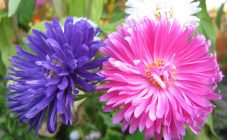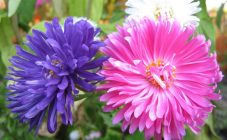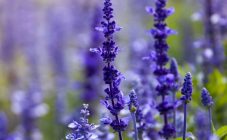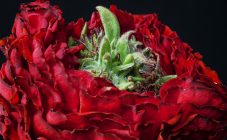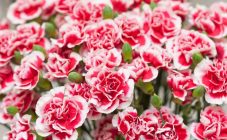Content:
Astra Novobelgiskaya (Astra Virginskaya) is a beautiful, lush bush with numerous star-shaped flowers, it belongs to a perennial, cold-resistant, herbaceous plant. Belongs to the Astrov family, or Compositae, grows everywhere (countries of Asia, Europe, Africa, America).
Assumptions about the original place of growth of the plant differ: the first hypothesis considers Asia, in particular, China, as the birthplace of the New Belgian aster, from where asters were brought to Europe by a French monk in the 17th century. Other sources claim that this beautiful bush is native to the eastern regions of North America. At the moment, the culture is widespread almost everywhere.
They began to cultivate aster since 1686, at the moment, due to the work of breeders, there are more than 1000 of its varieties.
In botany, aster is called Symphyotrichum novi-belgii, aster is translated as "star". In everyday life, "santbrinki", "octobrinks" are widely used, because the plant blooms just in September, October.
Beneficial features
Aster is widely used in folk medicine; flowers, leaves, roots and stems are used. The plant is rich in coumarins, saponins, flavonoids. Aster infusions are effective in the treatment of gastrointestinal diseases, colds, viral, joint diseases, eye and tuberculosis. Aster serves as an excellent antipyretic, relieves inflammation and itching.
Plant characteristic
New Belgian aster has many varieties, different in height, color of leaves and their length, is distinguished by a wide range of color shades of inflorescences.
Description of the aster:
- bush is reverse-pyramidal, densely leafy, highly branched;
- plant height - from 0.5 to 1.5 meters;
- linear-lanceolate (elongated) leaves with a blunt base, alternate, sessile, have no cutting (6-10 cm);
- foliage is dark green with a glossy surface;
- large paniculate inflorescences - baskets, up to 2-4 cm in diameter, with a yellow center, petals of various colors (lilac, pink, white, purple);
- powerful root system;
- stems are numerous, closely adjacent to each other, thin, strong, slightly pubescent;
- Excellent winter hardiness, frost resistance.
Flowering period
The plant is late flowering. Depending on the variety, flowering begins in July and ends in November. Few varieties bloom before the first frost. It blooms for a long time, within 35-60 days. Pollinated by insects, just heaps of butterflies, bees and many other insects hover over the plant. The fruit is a capsule.
Characteristics of varieties
On the basis of pure New Belgian asters, as a result of the diligent work of breeders, many different varieties and hybrids have been obtained. The most popular ones are below.
Astra Marie Ballard
Marie Ballard (Mary Ballard) is a plant, 1-1.1 m tall, with falling side shoots. Inflorescences are cupped, 3.5-4 cm in diameter. Reacts poorly to dry soil, prefers sunny, warm places with fertilized soil. Flowering begins in June and lasts until November.Astra Maria Ballard has blue or blue-purple flowers. Long-term flowering, at least 2 months. Aster was bred in 1955 by the famous breeder Ernest Bollard and named after his beloved Mary.
Astra Royal Ruby
Differs in large, bright crimson flowers. The bush forms a lush, up to 1.2 meters high. Flowering begins in late August, it lasts a little less than a month. It stands out for its excellent winter hardiness, does not require shelter.
Astra White Leads
A gorgeous, powerful bush that reaches over 110 cm in height. Differs in incredibly multiple colors, snow-white color. Prefers well-lit, warm areas. Blooms profusely from September to late October.
Astra Starletta mix
Densely leafy bush with large purple flowers, long and abundant bloom. Not picky about the soil, agricultural technology.
Astra Crimson Brocade (Aster novae—belgii ‘Crimson Brocade‘)
It is a very strong garden perennial. Bushes are dense, dense, bloom very beautifully. Abundant flowering, amicable, late. The flowers are bright red or crimson. The variety has a high winter hardiness (up to 40 ° C).
Astra Novobelgiskaya: landing and care
Landing
The site is chosen sunny, protected from the winds, with a light soil of neutral acidity. It is optimal to choose a loamy soil with good air permeability. They do not tolerate lands with stagnant moisture.
Step by step procedure:
- The seat is prepared in the fall: shovels are well dug into 1.5-2 bayonets, humus is added.
- In early spring, they dig up this place again, remove the overgrown grass, add superphosphate and calcium sulfate.
- Planting places are located at a distance of at least 30-50 cm between each other (for taller varieties, respectively, more space).
- When planting, the roots should be straightened, they are sprinkled with earth, slightly tamped.
- Sprinkle with water.
Care
Despite good winter hardiness and strong immunity, aster needs care. Otherwise, instead of lush flowers, thin bare stems of a drooping bush will flaunt. Necessary manipulations:
- watering (high humidity is fraught with powdery mildew, so it is important not to overdo it, the plant tolerates drought well);
- regular weed removal;
- disposal of faded buds;
- systematic loosening;
- top dressing.
The plant must be fed with complex fertilizers three times per season:
- 2 weeks after planting;
- during bud formation;
- during flowering.
Reproduction
Astra Belgian reproduces by seeds, cuttings and dividing the bush.
Sowing seeds has two ways:
- seedling;
- reckless.
Seedling
The soil is collected from: one part of sand, mullein and sod land and seven parts of peat. The soil is disinfected with potassium permanganate. The room should be bright, with a temperature of at least 20 ° C. The planting must be moisturized regularly. After the first sprouts, the temperature drops to 15 ° C. Seedlings are planted at the age of 65 days, a couple of weeks before that they begin to harden.
Seedless
Seeds are sown directly into open ground before winter (November, December). Small grooves are formed, the seed is sealed there, watered abundantly with warm water and sprinkled with earth (5 mm). After the appearance of real leaves (2-3 pieces), the planting is thinned out.
Dividing the bush
This is the easiest way to breed asters. They take a bush of the New Belgian aster and, using a sharp shovel, cut off a part from it, which is subsequently divided into smaller plots containing at least 3 shoots.
Cuttings
The procedure can be carried out all summer (May-August). Use apical cuttings that are at least 5-7 cm long.It is required to plant the twigs in a new soil prepared from: 1 part sand, 1 part peat and 2 parts turf. The planting is covered with plastic wrap for 25-30 days.
Diseases and pests
Aster is most susceptible to powdery mildew, which very much spoils the appearance of the plant, covering it with a white bloom. Long rainy weather favors its appearance. For prevention, special chemicals are used or the plant is properly looked after, which definitely strengthens its health and reduces the risk of disease.
Rust is unambiguously less common, manifests itself in the form of "rusty" spots on the top of the sheet. The leaves are cut off, the plant is sprayed with fungicidal agents.
Verticillous wilting - only the transplanting of a perennial plot into fertile soil will save. During the procedure, the rhizome is sprayed with Maxim or Vitaros preparations.
From pests on aster settle: leafhoppers, aphids, ticks, slobbering pennies, acaricides. To prevent them:
- in the fall, they thoroughly dig up the soil;
- keep the distance between plants during planting;
- timely remove dying shoots of the plant;
- feed the soil.
Growing an aster does not require much work, it is not capricious, not picky in care, but how fabulous the garden makes - just unrealistically beautiful bushes, especially highlighted against the background of faded yellow plants in the autumn period.







